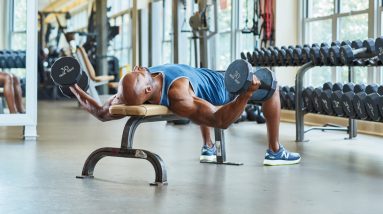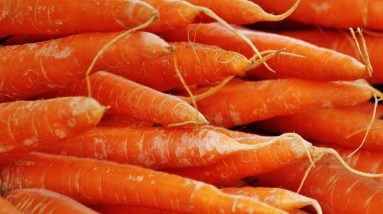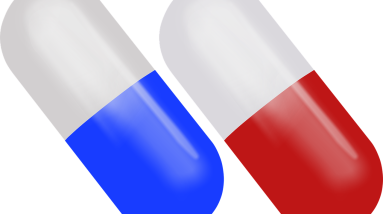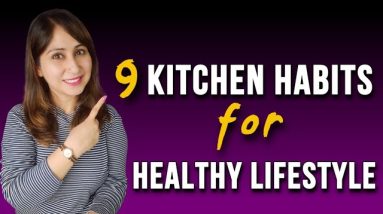
Elevate Your Workout’s Mental Health Benefits with a Beach, Lake or River Session
Glancing through resort advertisements, you can’t help but notice the overwhelming presence of ocean and coastline beckoning you to leave all your stressors behind. It’s no accident that blue spaces—which include all waterscapes and their environments—are front and center in vacation ads, or that condos with a water view are priced at a premium. Humans feel an ancient and irresistible pull toward the water, and the fields of evolutionary and psychological study have been turning up evidence of how deep and influential this drive can be.
Essentially, blue spaces have the power to improve our mental and physical health and foster meaningful mind-body connections—similar to the way that exercise can. “A blue space setting can increase one’s physical activity levels, boost mood and well-being, and lower stress and anxiety,” says Reena B. Patel, LEP, BCBA, positive psychologist, and licensed educational board certified behavior analyst.
Taking your workouts to the beach, lake, river, or any other space near a natural body of water may provide compounding benefits beyond those you’d get from indoor gym sessions. “While exercise has many physical health advantages, it also plays a beneficial role for our mental well-being, and pairing fitness and movement with blue areas can increase both,” says Patel.
Benefits of blue spaces for mind and body
Researchers have reached the consensus that human relationships to water influence identity; sense of belonging and place; and physical, emotional, and spiritual wellness. Throughout history, waterscapes have been a destination for relaxation, fun, sport, and leisure, while also being considered healing and invigorating. While this has been obvious in so many cultures for thousands of years, science also backs it up.
“Being in natural spaces has been shown to improve well-being by lowering stress levels and reducing symptoms of anxiety and depression,” says Amy Mezulis, PhD, co-founder and chief clinical officer of online therapy platform Joon. “Time spent in blue spaces may help people buffer against the effects of stress by reducing sympathetic nervous system activation, lowering cortisol levels, and expanding the internal ability to access good coping resources.”
So, what does that all mean? A calmer, less stressed version of yourself.
“Sensory input is a key component to cultivating mindfulness, and mindfulness has both direct and indirect mental health effects,” adds Dr. Mezulis. Blue spaces offer plentiful sensory input, such as the color contrasts of water against the landscape and the sounds and smells associated with that water and its movement. “This sensory mindfulness, in turn, supports us in slowing down, grounding in the present reality, and finding a sense of inner peace,” Dr. Mezulis explains.
Combining fitness with blue spaces
It seems that simply existing near water can lead to more movement in your life. In fact, access to blue spaces is associated with significantly higher physical activity levels, according to findings published in The International Journal of Environmental Research and Public Health. The more blue spaces near your home, the more likely you are to be active, which makes sense: In addition to providing opportunities to swim or row a boat, many lakes and rivers are flanked by running and biking paths, while sandy beaches naturally invite active recreation, from surfing to volleyball to long walks (romantic or otherwise).
Interestingly, several studies have found that physical activity is the key ingredient that connects being in natural spaces to better well-being. “People who use blue and green spaces for physical activity have better mental health outcomes than those who do not,” says Dr. Mezulis. Of course, we know that physical activity has major mental health benefits, like lower stress, improved perspective, and a better ability to problem-solve. “Physical activity in a blue space maximizes those benefits,” she adds.
According to Dr. Mezulis, being active in spaces that encourage mental and physical balance likely helps you benefit further from connecting your mind and body. “Any time we want to engage in behaviors that promote our mental health and well-being, two important components are time and intention,” explains Dr. Mezulis. “We can gain the most benefits from blue spaces when we make it a priority to spend time in those spaces with the intention of making that time beneficial for our mental health.”
How to get started
If you want to reap these benefits, intentionally schedule regular time to be in blue spaces and plan physical activity around those opportunities. Maybe it’s taking a walk to a local pond or river, or going swimming in a lake. Even simple strolls alongside streams or brief toe dips into the ocean can have mental health benefits if you bring a reflective mindset with you.
Or, if you’re feeling adventurous, incorporate the water itself into your workout and make exercise more exciting by trying paddleboarding, surfing, or kayaking to add variety.
Above all, be mindful: “Stay present by taking time to appreciate its beauty,” suggests Patel.

Discover the Effective Feeder Workouts: Unlock the Secret to Building Impressive Muscle Mass
Feeder workouts are quick, high-volume, light weight workouts, that can help increase blood improve muscle size and strength. Coined by bodybuilder Rich Piana, feeder workouts can help improve muscle size by constantly providing or feeding the muscle, with more nutrients, blood flow and oxygen. We’re going to talk more about feeder workouts and how this workout protocol can help you grow more size where you need it.
What Are Feeder Workouts
The theory behind a feeder workout, is that low weight, high volume workouts, performed every day, at 2-3 sets of 20-50 reps can help significantly add more size and strength. For example, performing light weight bicep curls, at 100 reps, every night will provide more nutrients, blood flow and oxygen, thus “feeding” your muscle tissue and help you grow more size.
Do Feeder Workouts Work
According to the principles of muscle protein synthesis, feeder workouts, should in fact, be able to increase muscle size and strength.
Muscle protein synthesis is the biological process of building new protein cells to rebuild and repair muscle tissue, via amino acid utilization. This biological process is a result of intense physical stress, caused by micro-tears and mini trauma done to the muscle tissue during training. Although you’re not using heavy weight in a feeder workout, does not mean it is not intense, or creating micro-tears in the muscle.
Studies suggest that the intensity/workload is negligible on the rate of MPS. MPS is truly controlled by exercise in addition to nutrient intake.
The human body is comprised of 650 skeletal muscles, composed of thread-like myofibrils and sarcomeres which can achieve growth, through the process of repeated muscle contraction. The metabolic change for how muscles grow, is an increase in net muscle protein balance, which is simply the difference between muscle protein synthesis and muscle protein breakdown. An increase in net muscle protein balance, is a direct response to resistance training and nutrition which stimulate anabolic response through muscle protein synthesis [R].
Muscle growth takes place in two different forms, hypertrophy and hyperplasia. Hypertrophy is an increase in muscle size due to an increased in the size of muscle muscle fibers, while hyperplasia is an increase in the number of muscle fibers. Hypertrophy is achieved through increased muscle tension and physical stress, breaking down muscle fiber. Growth is a result from overcompensation to protect the body from future stress [R].
Resistance training places intense physical stress on your muscle fibers, creating microtears and trauma to your muscle tissue, stimulating the muscle building process. The rate at which you build muscle depends on several variables related to resistance training, such as training volume, load, workout intensity, and duration. Maximizing muscle growth through training, will also depend on how many sets and reps you do.
Training for maximal muscle growth requires higher volume training and more intensity, with minimal rest periods. This will essentially force cellular changes which will result in increased muscle growth.
Therefore, feeder workouts, should in fact work, and work very well to induce more changes in muscle size and strength.
RELATED ARTICLE How Do Muscles Grow
The other component to muscle growth, is nutrition. Protein is vital to initiate muscle protein synthesis to rebuild and repair muscle. Protein is comprised of amino acids, which stimulate the muscle building process. This is why you see bodybuilders such as Piana supplement with a protein shake. It’s important to flood your muscles tissue with the fuel it needs to maximize performance. Drinking a protein shake before your workout will help elevate amino acids in your bloodstream at a much faster rate, than food alone. The short rush of amino acids is known as hyperaminoacidemia and stimulates greater amounts of muscle protein synthesis. Having a flood of amino acids post-workout is just as important, as it will help with muscle growth and optimize your post-workout recovery.
If you’re not exactly sure where to start with your nutrition, schedule a free nutrition consultation with a certified nutrition coach at The Swole Kitchen. Take the guess-workout out of your nutrition and get results right away.
Feeder Workouts: Takeaway
Adding feeder workouts to your normal training protocol, or workout split, could in fact help you grow muscle size and strength in acute areas of focus. If for example, you need to grow your biceps, or quadriceps for a more balanced physique, then you can add a feeder workout, with more volume, of 50-100 reps of bicep and leg curls to help grow more size and strength. Rich Piana was one of GOATS in bodybuilding and always had an amazing physique. So, it’s probably worth a shot.
Need Help With Optimizing Your Diet, Nutrition, And Training Plan To Finally Get The Results You’ve Been Waiting For Without Having To Diet At All?

SWOLVERINE IS AN ENDURANCE ATHLETE AND ACTIVE LIFESTYLE BRAND. MADE FOR THE ELITE ATHLETE, AND THE STRONG-WILLED OUR PRODUCTS WERE DESIGNED TO FUEL YOUR ATHLETIC PERFORMANCE. WE PERFORM WHEN YOU PERFORM.
We believe that everyone can optimize not only their athletic performance but their human potential. The way we believe we can optimize performance is through transparency, clinically effective doses, and clinically proven ingredients with evidence-based outcomes. We provide the nutrients you need to power your active lifestyle.

6 Causes and 5 Treatments for Chronic Inflammation: A Comprehensive Guide for Health and Fitness Enthusiasts
When you think about inflammation, typically you’ll think of joint pain after a grueling workout out, or inflammation caused by injury. This is what’s known as acute inflammation, or inflammation specific to one area of the body. But what about chronic inflammation. Chronic inflammation is a slow, long lasting and lingering form of inflammation that has many associated causes, which can become quite complex and debilitating. We’re going to talk about what chronic inflammation is, the causes, and how it affects you.
What Is Chronic Inflammation
Inflammation is your body’s natural defense mechanism. Inflammation is characterized by several factors, such as heat, redness, pain, or swelling. Inflammation is caused by a direct stimulus, such as a pathogen. Your body produces an inflammatory response to this stimulus. The goal is to respond to the stimuli, (an inflammatory response) restore balance and begin the healing process.
Chronic inflammation is described as slow, long-lasting, and persistent inflammation, which can last for several months of even years. Now, you may be thinking, well I’m not in pain, my joints aren’t swollen, so how could I have inflammation. Chronic inflammation is commonly known as hidden or silent inflammation. The extent and effects of chronic inflammation are dependent upon the severity of cause, as well as treatment protocol, and your body’s ability to repair and heal itself.
6 Causes Of Chronic Inflammation
On a molecular level, inflammation is often caused by several internal and external factors.
External factors can either be non-microbial or microbial. Non-microbial factors can include things such as allergens, irritants, and toxic compounds. The two main microbial factors are virulence factors and pathogen associated molecular patterns or (PAMPS). These virulence factors help pathogens colonize tissues and cause infection.
(PAMPs) are derived from microorganisms and recognized by pattern recognition receptor (PRR)-bearing cells of the innate immune system as well as many epithelial cells.
PAMPS are a diverse set of microbial molecules that share a number of different general “patterns,” or structures, that alert immune cells to destroy intruding pathogens. These microbial molecules, include, lipopolysaccharide (LPS), peptidoglycan, and lipoteichoic acid. Your immune system recognizes virulence factors and PAMPS as foreign substances and can trigger an inflammatory response against them.
Internal factors, include damage associated molecular patterns otherwise known as (DAMPS). These are intracellular proteins that are released when a cells plasma membrane is injured or when a cell dies. Therefore, DAMPS trigger inflammation, as a response.
1. Cortisol Levels
Lack of cortisol can greatly contribute to chronic inflammation. Cortisol is a potent anti-inflammatory hormone; it prevents the widespread tissue and nerve damage associated with inflammation.
Cortisol is a steroid hormone, specifically a glucocorticoid, which is made in the adrenal glands. Cortisol regulates a wide range of biological processes including metabolic and immune responses. It’s been widely studied that cortisol responsiveness is an important indicator and determinant in the metabolic response to stress, specifically the ‘fight or flight response’ which influences weight gain and obesity. Cortisol controls the body’s blood sugar levels, thus regulating metabolism.
Lack of cortisol is caused by having high blood serum levels of cortisol within the body, due to cortisol resistance. Conditions such as bursitis, arthritis, or tendonitis, characterized by inflammation, typically involves a lack of cortisol.
When our body contains low levels of cortisol, corticotrophin-releasing factor (CRF), (the principal regulator of the HPA axis) is secreted from the hypothalamus, which causes the pituitary gland to release another hormone, adrenocorticotropic hormone (ACTH). When the blood contains high levels of ACTH, it goes through a biological process called the Negative Feedback Loop. During this process the body secretes cortisol to regulate and maintain a steady hormone level. When ACTH is too high, the adrenal glands stimulate the release of cortisol, causing cortisol blood concentration to rise. As cortisol rises, it blocks the release of CRF and ACTH. As a result, ACTH levels start to drop, which ultimately leads to a drop in Cortisol. Thus, cortisol is regulated through a constant loop and cascade of biological reactions.
2. Chronic Stress
Several studies have shown that acute or chronic stress may lead to dysregulation of the hypothalamic–pituitary–adrenal (HPA) axis, which is mediated by inflammatory markers such as CRP and other stress hormones, including cortisol. Physical, mental, and emotional stress are all associated with inflammatory cytokine release.
Stress can also cause sleep disruption and chronic sleep disorder. Those with irregular sleep schedules are more likely to have chronic inflammation than consistent sleepers. Lack of sleep is therefore considered as an additional independent risk factors for chronic inflammation.
3. Sugar And Starch
One of the most common causes of inflammation, is from glucose. Too much sugar can produce an inflammatory response, which can lead to insulin resistance. Insulin is created by the pancreas. It’s an anabolic hormone within the body and happens to be the hormone that is secreted when blood glucose levels rise from eating carbohydrate-rich foods. After you eat, carbohydrates break down into glucose, Glucose then enters the bloodstream. The pancreas responds by producing insulin, which allows glucose to enter the body’s cells to provide energy. Excess glucose is stored as energy, in the form of body fat.
It’s important to recognize that carbohydrates are needed for normal biological function. There are certainly great sources of carbohydrates that are necessary for human and biological function. The carbohydrates that I am referring to, are sugar rich carbohydrates, such as processed foods, candy, and sugar loaded soft drinks.
If your cells become resistant to insulin, it will lead to elevated blood glucose levels, otherwise known as (hyperglycemia), and in time can lead to obesity and Type 2 diabetes.
4. Previous Injuries
Old injuries or trauma can cause chronic inflammation, through what’s called post-traumatic arthritis. Post-traumatic arthritis causes stiffness and pain in your affected joints. In most cases trauma or injury results in acute inflammation. It can however become a chronic condition. If you have old injuries, then reducing overall inflammation is crucial to the healing process.
5. Alcohol Consumption
Alcohol consumption can lead to inflammation, for several reasons. Alcohol is a toxin, and naturally your body will produce inflammation and stress trying to process it. Alcohol has a systemic effect on the gut microbiota. Chronic alcohol use impairs the balance of microflora in the gut, the gut barrier function, the liver’s ability to detoxify bacterial products and to generate a balanced cytokine milieu, and the brain’s ability to regulate inflammation in the periphery [R].
6. Unhealthy Gut Microbiome
Nearly all causes of inflammation can be directly traced back to the gut. 60-70% of your immune system is controlled by the gut. Pathogens, microbes, and foreign materials are constantly introduced to the gut, which can produce an inflammatory response.
If you have food allergies, such as a dairy sensitivity, gluten intolerance, or other sensitives, these constituents can be seen by the immune system as an invading allergen, irritant, or toxin.
Having a healthy microbiome, will help regulate the immune system, absorb more nutrients, and produce better defenses against invading pathogens. The gut lining or gut barrier is our first defense against inflammation, and when that barrier is breached, we produce systemic inflammation. This is called, gut hyper-permeability. This specific mechanism is directly correlated and characterizes the etiology associated with inflammatory bowel disease states, such as Crohn’s, Ulcerative Colitis, and irritable bowel syndrome.
RELATED ARTICLE 14 Studies That Prove Glutamine As A Potential Treatment Option For IBD
5 Potential Treatments For Inflammation – How To Control And Reduce Inflammation 1. Supplements (Turmeric, Krill Oil, Vitamin D3)
Several studies have demonstrated that supplements such as Omega-3s, Turmeric, and Vitamin D3 can help combat chronic inflammation.
Krill Oil
Omega-3s are essential fatty acids, also known as EFAs. The body requires EFAs for optimal health but cannot make these essential fatty acids on its own. EFAs are ‘essential’ meaning, these types of fats must be consumed in the diet or by a dietary supplement, such as Krill Oil. The human body requires both groups of EFAs (omega-3 and omega-6) to survive, however the typical modern-day diet, is much higher in Omega-6 fatty acids than Omega-3, making supplementation critical to your overall health.
Krill Oil comes from tiny shrimp-like crustaceans, which are found deep in the cold waters of the Antarctic Ocean. Krill oil is rich in long-chain omega-3 polyunsaturated fatty acids (PUFAs), eicosapentaenoic acid (EPA), and docosahexaenoic acid (DHA), which have been found to have positive effects on inflammation, decreasing oxidative stress, and enhancing recovery [R]
In a study conducted at the University of Pittsburgh Medical Center, 125 patients that were diagnosed with nonsurgical neck or back pain were administered 1200-2500mg of Omega-3 fatty acids per day. After 75 days, fifty-nine percent discontinued taking their prescription NSAID medications for pain. Sixty percent stated that their overall pain was improved, and 60% stated that their joint pain had improved. Eighty percent stated they were satisfied with their improvement, and 88% stated they would continue with Omega-3 supplementation. This study concluded that Omega-3 supplementation demonstrated an equivalent effect in reducing arthritic pain, as does Ibuprofen [R].
Studies have proven that krill oil helps reduce joint pain and arthritic symptoms by directly reducing the amount of C-reactive protein in the blood; a protein made by the liver in response to inflammation. Therefore, if you’re experiencing post workout joint pain, or exhibit mild arthritic symptoms, krill oil can potentially help reduce pain and joint discomfort [R].
RECOMMENDED PRODUCT Krill Oil (60 Servings with Astaxanthin)
Vitamin D3
Obtained from the sun and synthesized through the skin, vitamin d is an integral component of overall health and wellness. Vitamin D is unique in the fact, that it doesn’t function like a vitamin, but more like a hormone. Classified as a pro-hormone, Vitamin D is an essential component in bone and mineral metabolism.
Often hard to obtain through dietary sources alone, supplementation is crucial for health and wellness. According to a national nutrition examination survey 41.6% of US adults exhibited vitamin d deficiency, with the highest rate seen in African Americans at 82.1% followed by those of Hispanic descent at 69.2% [R]. Since Vitamin D is a fat-soluble vitamin, it’s crucial that you pair vitamin d with a fat, to enable optimal absorption and calcium uptake. Swolverine’s Vitamin D3 is 10,000 IUS suspended in olive oil for optimal absorption and potency.
Several studies have shown that Vitamin D3 has analgesic and anti-inflammatory properties, and effects.
A Swiss study, conducted at the University of Bern, found that 71% of study participants exhibiting chronic pain and hyperalgesia were Vitamin D deficient.
Another interesting study examined 120 children who were exhibiting recurrent growing pains, lasting more than 6 months. Following vitamin D supplementation, the mean VAS score (commonly known as pain score) was reduced from 6.8 to 2.9, resulting in a mean reduction of 3.8 at the 3 months follow up. A reduction of 57% [R].
Several observational and controlled studies have found that vitamin d deficiency may be related to chronic musculoskeletal chronic low back pain [R, R, R]. In a very large observational study with over 9,000 study participants, it was found that low vitamin d levels was directly related to back pain, to its severity, and to difficulty in performing daily activities.
Chronic in-healable wounds are often associated and can be a sign of low vitamin d levels and chronic inflammation. Vitamin D3 is vital in the crucial for the production of new skin and as part of the wound healing process. A study examining the effects of Vitamin D on patients with foot ulcers due to diabetes found that Vitamin D may play an indirect role in wound healing due to its effect on improved glycemic control.
RECOMMENDED PRODUCT Vitamin D3 (10,000 IUs w Olive Oil)
Turmeric
Turmeric has gained an immense amount of popularity amongst athletes and general health enthusiasts, due to its many proposed health benefits and anti-inflammatory properties associated with its active ingredient curcumin.
RELATED ARTICLE How To Reduce Joint Pain In 6 Simple Steps
Turmeric contains over one hundred unique chemical properties that contribute to its countless therapeutic and anti-inflammatory effects. Research suggests that Turmeric’s active ingredient Curcumin, which gives turmeric it’s beautiful yellow-orangish color is responsible for the myriad of health benefits associated with Turmeric. Curcumin is a polyphenol (micronutrients that are packed with antioxidants) and targets multiple signaling molecules at the cellular level. Curcumin has proven to have powerful antioxidant and anti-inflammatory benefits, which can help in the management of exercise-induced inflammation and muscle soreness, thus enhancing recovery, and optimizing performance.
RELATED ARTICLE The Ultimate Guide To Turmeric
Research has shown that curcumin is a highly active molecule that modulates the inflammatory response by inhibiting the production of inflammatory cytokines. This is especially beneficial to those athletes that participate in high impact or high-intensity functional training.
Evidence suggests that Turmeric also provides similar analgesic (pain reducing) and anti-inflammatory effects as ibuprofen. Considering that Turmeric is a naturally sourced herbal remedy and ibuprofen is an over the counter NSAID (Nonsteroidal anti-inflammatory drug), turmeric is a safer and natural alternative to Ibuprofen for inflammation and post-workout joint pain.
RECOMMENDED PRODUCT Turmeric (750mg curcumin)
2. Eliminate Allergens
If you have food allergies, or sensitives, one of the easiest ways to reduce systemic inflammation is to simply eliminate them from your diet.
For example, gluten is a large water-soluble protein, that creates elasticity in dough, also known as lectin. Gluten is found in most common grains and some other types of legumes. Gluten can cause inflammatory response in the gut, and create IBS like symptoms such as bloating, abdominal pain, bowel movement disturbances, and nutritional deficiencies for some people.
People with lactose intolerance are unable to fully digest or metabolize the sugar (lactose) in milk. As a result, they have diarrhea, gas and bloating after eating or drinking dairy products. The condition, which is also called lactose malabsorption, is usually harmless, but symptoms can cause inflammation. If you have this type of sensitivity, it’s always best to severely restrict or eliminate them, to avoid chronic inflammation.
3. Eat Healthy Whole Foods
Controlling inflammation is key to lowering cortisol levels and correcting hormonal imbalances. Following an anti-inflammatory diet that consists of wholesome natural foods which include hormone free lean proteins, healthy fats high in Omega 3, quality carbohydrates, cutting out processed meats, and eating more food high in antioxidants will all contribute to a well-rounded anti-inflammatory diet. With less inflammation, your body will maintain steady levels of cortisol, so that you do not create added body fat. Remember, that cortisol is controlled through activity patterns, and if you can control your activity to be steady and incorporate healthier practices, you can successfully lower your cortisol levels, manage stress, and reduce inflammation.
If you’re not sure where to start with your diet, what to eat, or how to reduce inflammation through your diet, consult one of certified nutrition coaches at The Swole Kitchen.
4. Reduce Sugar Intake
Refined sugar, and simple carbohydrates can cause chronic inflammation, especially with repetitive intake which can contributing to insulin resistance. By efficiently reducing your consumption of refined sugar and starchy foods, you can improve your insulin sensitivity and reduce chronic inflammation.
5. Reduce Alcohol Intake
Reducing your alcohol intake can great help reduce chronic inflammation. Your body will naturally produce inflammation to process toxins, which can place your gut and liver in state of overload.
Alcohol triggers the danger signals in your immune system since it is recognized as a foreign substance.
In response to such signals, innate immune cells, such as macrophages, release pro-inflammatory cytokines [R].
Chronic Inflammation: Takeaway Need Help With Optimizing Your Diet, Nutrition, And Training Plan To Finally Get The Results You’ve Been Waiting For Without Having To Diet At All?

SWOLVERINE IS AN ENDURANCE ATHLETE AND ACTIVE LIFESTYLE BRAND. MADE FOR THE ELITE ATHLETE, AND THE STRONG-WILLED OUR PRODUCTS WERE DESIGNED TO FUEL YOUR ATHLETIC PERFORMANCE. WE PERFORM WHEN YOU PERFORM.
We believe that everyone can optimize not only their athletic performance but their human potential. The way we believe we can optimize performance is through transparency, clinically effective doses, and clinically proven ingredients with evidence-based outcomes. We provide the nutrients you need to power your active lifestyle.

Maximize Your Chest Gains: Avoid These 4 Flye Mistakes
The bench press and its variations still remain the go-to exercises to build size and strength in the chest. But don’t discount the dumbbell chest flye and all its pec-pumping versions. The beauty of this exercise is that it takes much the triceps out of the move so you can focus on the chest just as long as you keep away from some of the common dumbbell chest flye mistakes.
Many lifters can’t “feel” their chest working with some press variations, and the dumbbell chest flye solves this problem. When performed with good form, the dumbbell chest fly will encourage an excellent mind-muscle connection for better gains.
But a one of the most common dumbbell chest flye mistakes is that some think more is better and let ego get in the way of their gains. Here we’ll briefly explain how to do the dumbbell chest flye and four common chest flye mistakes that’s stopping you from getting a massive chest pump.
How to Do The Dumbbell Chest Flye
- Lie face up on a flat bench with dumbbells held with a neutral grip near your chest.
- Press the weights to the lockout position with the dumbbells touching.
- Lower the weights laterally, slightly bending your elbows to avoid elbow strain.
- When the dumbbells are at shoulder level, squeeze your chest muscles, and bring the weights back to the lockout position.
- Reset and repeat.
What’s Needed For Good Form
The dumbbell chest flye is not a technical exercise like a deadlift or bench press and will benefit anyone from beginner to advanced lifters. But like most exercises, there are better ways to do it to get the most out of it. Here is what’s needed for good chest fly form.
- Decent shoulder mobility and health: If you have problems with either, this may not not the exercise for you.
- Healthy elbows: Even though the triceps are not involved, flyes put stress on the elbows, and if you have pain there, again, this is not the exercise for you.
- Grip strength: if you cannot grip it, you cannot rip it, and the dumbbell chest flye requires you to hold on tight to keep your wrist neutral. When the wrist hyperextends, good things will NOT happen.
- Shoulders externally rotated: If you have a caveman posture, you will find this exercise difficult to do with good form. Externally rotating the shoulders engages the upper back and helps open the chest for the best results.

Pound your pectorals with this dumbbell-only routine
Read article
4 Common Chest Flye Mistakes
It is a simple exercise requiring no special knowledge or insider secrets. But that doesn’t mean you cannot make mistakes. You should avoid these four common mistakes to get the best out of this chest isolation exercise.











